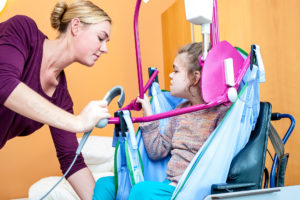Our Oregon Ataxic Cerebral Palsy Lawyer in Oregon Explains What You Need to Know After Your Child was Diagnosed
If your infant stops responding to your voices or stops following you, then it could be very concerning for you. You might be wondering if this is normal for an infant. The concern could grow if your child cannot stand even after being a year old. You might be pondering if this is a birth injury or a cerebral palsy. Many people have heard of cerebral palsy, but little people know exactly how it works. What is worse is when your doctor does come back to tall you that your child was diagnosed with ataxic cerebral palsy in Oregon, but you do not know what that is either.
This is why our Portland cerebral palsy law firms works hard to both fight for victims and their families, but also works hard to help education victims and their families about medical malpractice that could result in serious birth injuries such as cerebral palsy. There are four different types of cerebral palsies and the ataxic cerebral palsy is the rarest form of it. If your child happens to be suffering from an ataxic cerebral palsy caused due to a traumatic birth injury, then you should consult one of our experienced Oregon ataxic cerebral palsy lawyers. Our experienced Oregon ataxic cerebral palsy lawyers will do a thorough review of your case and inform you about your family’s rights and help to protect those rights. At Kuhlman Law, we offer free reviews and consulting our Oregon ataxic cerebral palsy lawyers will come at no added risk to you.
What is Cerebral Palsy?
The word Cerebral palsy is used to refer to the various movement disorders in the brain. The word “cerebral” stands for brain and “palsy” stands for weakness. The Centers for Disease Control (CDC) has reported that around 1 in 323 children suffer from a kind of Cerebral Palsy. This means that CP is a movement disorder affects a person’s ability to move and coordinate movement effectively.
Causes of CP
Cerebral Palsy normally occurs when there is a disruption in the brain development of a child. This results in the movement centers of the brain being damaged, or underdeveloped. In general, cerebral palsy is caused when:
- The mother suffers infections during pregnancy that affects baby’s brain.
- The child suffers from jaundice and kernicterus
- The child has a low birth weight
- The child is born prematurely
- The child is part of a twin, or triplets, etc.
- The mother suffers an uterine rupture, and
- There is a medical malpractice or negligence.
Common Ways Medical Malpractice Causes Cerebral Palsy
Under Oregon law, a doctor is required to act in a reasonable manner as other doctors would have in a similar situation given the skills and experience. When the doctor fails to do so, and does not meet the standards that is required from him or her then it could result in medical malpractice. Any kind of negligent behavior from the doctor could also be termed as malpractice.
There are several causes that have been specifically linked to Ataxic cerebral palsy in Oregon due to medical malpractice and birth injuries. They include:
- Failure to handle the baby with care.
- Failing to provide proper pre-natal care.
- Giving too much pitocin or giving overdoses of other medications.
- Failing to perform C-section on time.
- Failing to resuscitate a child on time.
- Using the birth tools carelessly or negligently.
- Birth hypoxia (which is caused when the brain does not get sufficient oxygen)
- Birth anoxia (which is caused when they brain does not get any oxygen)
- Ischemic strokes (when a blood clot affects a vessel in the brain)
General Types of CP
There are four distinct categories of cerebral palsy, including spastic cerebral palsy, dyskinetic cerebral palsy, Ataxic cerebral palsy, and mixed cerebral palsy. The exact type of cerebral palsy is determined in a child’s brain by taking a look at the exact location of the disease and analyzing the severity of the damage. This early diagnosis generally helps the doctors to determine the kind of treatment a child would need in the duration of his life.
Ataxic Cerebral Palsy
Ataxic cerebral palsy is a very rare type of cerebral palsy. It accounts for a mere five percent of the total cerebral palsy cases. Children suffering from ataxic cerebral palsy tend to shake, that is the reason why this disease is often called as the “shaky” cerebral palsy.
Brain has three important parts that control the whole body’s movements. Cerebellum is the part that controls the body’s balance. The cerebellum could be damaged sometimes if the baby suffers a traumatic injury during pregnancy, or during birth. This damage ends up causing Axatic cerebral palsy. If a baby suffers from Axatic cerebral palsy, the baby could be showing mild symptoms like finding it difficult to grasp the mother’ arms or sever symptoms like difficulty in swallowing food. The severity of the damage to the cerebellum will determine the range of impairments and their degrees that a child will suffer.
Children suffering from Axatic Cerebral Palsy may have trouble swallowing as mentioned above. They could face serious hardships when they try to hold a pen or a spoon because of their shaking. They often keep their legs wide apart when standing to ensure that they maintain balance. The symptoms of the Axatic Cerebral Palsy are normally not detectable during infancy because infants are not expected to stand or hold things in their hands.
Symptoms of Ataxic Cerebral Palsy
Some of the common symptoms shared by children suffering from Axatic Cerebral Palsy include:
- Widespread feet to maintain balance.
- Difficulty in maintaining balance.
- Frequent Tremors
- Having difficulty to move their eyes.
- Bad motor skills
- Poor speech filled with jerks.
- Bad hand and eye coordination.
Diagnosing Ataxic CP
A child with Ataxic cerebral palsy can be diagnosed between the ages of two and four. If the child has suffered a traumatic birth injury then the healthcare professionals are usually on the lookout for any kind of symbols for the disease.
There is no specific test to diagnose a child that is suffering from Ataxic cerebral palsy. Thus, it is important to look at the child’s milestones and its development to look at the symptoms.
Our Oregon Ataxic cerebral palsy lawyers want you take note of some those milestones:
Does your baby respond to your voice from birth?
Can your baby grasp his toys at the age of four months?
Can your baby stand or walk at 12 months?
Can your baby run at the 18 months of age?
Can your baby speak at 24 months?
Can your baby solve simple puzzle at the age of 36 months?
You should also keep in touch with your healthcare provider and ask them to regularly check his or her muscle strength, and movements. You should also take note of the social skills of your baby.
You can also consult medical experts and ask them to do some tests like CT scan, a brain MRI or an EEG to figure out what exactly is affecting your child’s mental and physical growth. These tests could be used to rule out other conditions that maybe affecting your child’s health.
Treatment for Ataxic CP
There is no cure for cerebral palsy. The symptoms associated with Ataxic cerebral palsy are not always progressive and it will not get any worse. There are various treatments that can used to ease the pain of the child suffering from Ataxic cerebral palsy. With proper medications and therapies a person diagnosed with Ataxic cerebral palsy can lead a satisfactory life.
Some of the Medications for Ataxic cerebral palsy include:
- Pain medications like aspirin, steroids and corticosteroids to reduce the pain and increase comfort levels of the child.
- Antispastic medication like diazepam and baclofen to relax muscles and reduce spasms.
- Anti-anxiety medications can be prescribed to help deal with anxiety and stress.
- Anticholinergic medications can be given to help with uncontrolled body movements like jerky movements and slow writing movements.
- Laxatives can be given to those who suffer from constipation.
- Anticonvulsant medications like benzodiazepines can be given to prevent epileptic seizures.
Medical Professionals
The Oregon ataxic cerebral palsy lawyers in our team advise that an entire medical team should coordinate with the family to make a unique plan for your child suffering the disease. As your child grows, the treatment plans should change as well. Some of the medical professionals who would look after your child include:
- Pediatrician – To look after your child’s health when he or she is an infant or during adolescent.
- Neurologist – To diagnose, treat any damages to nervous system or the brain.
- Occupational therapist – To help improve your child’s fine motor skills. They will take care of your child’s daycare tasks like eating, drinking and writing.
- Rehabilitation specialist – To help improve your child’ gross motor skills. It will increase your child’s muscle flexibility and help walk, stand and sit in a better way.
- Speech therapist – To help with your child’s speech.
- Dietician – To help create a proper nutritious diet for your child as he or she grows up.
- Psychologist – To deal with your child’s anxiety and depression issues.
- Ophthalmologist – To help with child’s eye problems and manage vision problems.
- Orthopedic Surgeon – To operate on your child’s bone, muscle, or joint if there is need for it.
- Otolaryngologist – To help with your child’s ear, nose and throat issues.
Call Our Birth Injury Lawyers Who Handle Ataxic Cerebral Palsy in Oregon
If you or a loved one have been seriously injured or killed as a result of medical malpractice contact the Oregon Medical Malpractice Lawyers at Kuhlman Law at our number below or fill out the intake form. We offer a free initial case evaluation and handle cases on a contingency fee which means that you pay no money unless we recover.
Our law firm handles cases throughout the state including Bend and Portland Oregon, Redmond, Central Oregon, Sisters, Madras, Multnomah County, Deschutes County, Salem, Eugene, Corvallis, Lane County, Medford, Gresham, La Grande, Albany, Medford, Beaverton, Umatilla, Pendleton, Cottage Grove, Florence, Oregon City, Springfield, Keizer, Grants Pass, McMinnville, Tualatin, West Linn, Forest Grove, Wilsonville, Newberg, Roseburg, Lake Oswego, Klamath Falls, Happy Valley, Tigard, Ashland, Milwakie, Coos Bay, The Dalles, St. Helens, Sherwood, Central Point, Canby, Troutdale, Hermiston, Silverton, Hood River, Newport, Prineville, Astoria, Tillamook, Lincoln City, Hillsboro, and Vancouver, Washington.
We also have an office in Minneapolis, Minnesota and take medical malpractice cases throughout the Twin Cities, including St. Paul, Hennepin County, Ramsey County, Dakota County, Washington County, Anoka County, Scott County, Blaine, Stillwater, and Saint Paul Minnesota.




